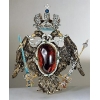|
 Hyacinth is
the dark-yellow or red, or crimson translucent kind of zircon. The primary color
of the mineral is red. In the East, hyacinth is believed to be the «brother» to
diamond. Pliny the Elder depicted the hyacinth as the very different from
amethyst, although the color is rather similar. The biggest disparity is that
bright purple color, which is so luminous in amethyst, while the hyacinth looks
diluted. Hyacinth possesses fascinating properties: its lovely luster is lost
when exposed to fire and ... bad weather. Stone is amazingly responsive to
changing weather, and truly addictive to the climatic changes. Hyacinth is
the dark-yellow or red, or crimson translucent kind of zircon. The primary color
of the mineral is red. In the East, hyacinth is believed to be the «brother» to
diamond. Pliny the Elder depicted the hyacinth as the very different from
amethyst, although the color is rather similar. The biggest disparity is that
bright purple color, which is so luminous in amethyst, while the hyacinth looks
diluted. Hyacinth possesses fascinating properties: its lovely luster is lost
when exposed to fire and ... bad weather. Stone is amazingly responsive to
changing weather, and truly addictive to the climatic changes.
It is thought
that the hyacinth as a stone refers directly to miserable love, and if it's
ever been, it could estrange a lover. Perhaps, the conviction is directly
related to the legend, poetically told by Ovid.
The story
of the stone that Ovid described in his «Metamorphoses» is as follows. The King
of Sparta, Amikla, and his wife, Diomedes, had a son, Hyacinth, amazingly handsome
and graceful person. The young man was a friend and favorite to the God Apollo,
but the God of the west wind, Zephyr, felt very jealous of this friendship.
However, to be precise, it was not so much envy as jealousy since Zephyr himself
was in love with Hyacinth. One day, obsessed and overwhelming with jealousy,
Zephyr saw Apollo teaching Hyacinth to throw discs, and the God of the west
wind changed the flight path of the disc gently nudged him. He had the power to
do that, you know. The disk bounced off the ground and struck Hyacinth on the head.
The young man fell and started bleeding. Apollo, seeing that his friend was
dying, whispered in despair that his heart would live as long as people would
think and bear in mind Hyacinth. And then curls of Hyacinth became of that beautiful
scarlet color, and the blood spilled on the ground, petrified and turned into a
precious gem of a wonderful beauty. Flowers and stones retained marvelous
beauty of youth of him.
That's such
a beautiful legend about the appearance of hyacinth in the world. Definitely, we
never know the favorites of Apollo, but the myth of Hyacinths lives in the
heart of people not for a single one millennium.
It is
believed that the hyacinth is mentioned as a stone to be the eleventh base of the
walls of the Heavenly Jerusalem (Revelation, XXI, 20). But the absolute
confidence is not there to talk about hyacinth, those days blue gems and other
stones of a yellowish or pink (beryl, topaz, etc.) was called hyacinth.
Hyacinth
has always been regarded as a talisman. It was used to improve memory and
increase intelligence, as an amulet of scientists and travelers (it attracted some
people to science, and protected others from snakes and wild animals). Hyacinth
was called the stone of sorrow and grief, and it was also attributed calming
effect, like an antidepressant. For example, Gerolamo Cardano would wear
hyacinth as a means from insomnia. He alleged that the stone was really sleepy,
but did not do too effectively. As the possible reasons for this «failure» of hyacinth
Cardano accused of the quality of the stone, he complained that his hyacinth was
defective. But the Mother Superior of the monastery Hilde-garda from Britain
of XII century recommended hyacinth from edema of eyes. The stone should be heated
in the sun, moistened with saliva and attached to the sore eyes.
In the XIX
and early XX century hyacinth was very popular as the stone of merchants and
artists. The largest hyacinths can be seen in the Smithsonian Institute (USA, Washington) as brown minerals of 118.1 and
87.6 carats and yellow stones of 23.5 carats from Sri
Lanka, and the 102.2 carats blue stone came from Thailand.
Mostly
hyacinths are mined in alluvial deposits of Sri
Lanka (almost fully developed), Thailand and Madagascar.
Now the fame
of hyacinth is back again, not so much as a mascot (although the passion for
esoteric sciences draws attention of the mystery admirers to the hyacinth), but
as ornaments of astonishing beauty. Especially hyacinth is good in rings,
bracelets and necklaces, crowded with other stones and gems only to highlight
the delicate charm of hyacinth.
With return
of the Byzantine splendor of fashion jewelry, the leading jewelry houses have
begun to actively employ the hyacinths in their collections. So, Roberto Bravo,
included the stone in the jewels collection elegantly matching classic grace
with a riot of colors of precious stones, and Leon Hatot also boasted with
hyacinth whose jewels are famous for romantic elegance.
The
designers use hyacinths as a trimmer, for example small hyacinths around a
large central stone like ruby or amethyst look perfect. The other options are
possible when large hyacinth is surrounded with other finer stones. Hyacinth is
mostly worked up with cabochon, and acquiring such a decoration, you should be
careful since fakes are common. Main difference of fakes from the real stone is
uneven color, thus, be careful.
|